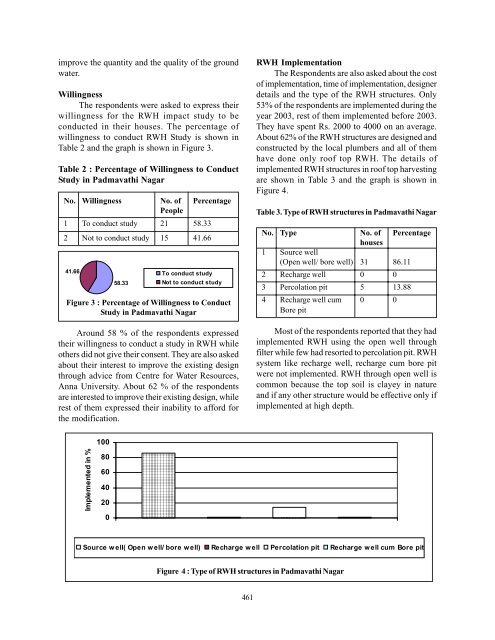Accepted Papers - 3.pdf - UNESCO
Accepted Papers - 3.pdf - UNESCO
Accepted Papers - 3.pdf - UNESCO
You also want an ePaper? Increase the reach of your titles
YUMPU automatically turns print PDFs into web optimized ePapers that Google loves.
improve the quantity and the quality of the ground<br />
water.<br />
Willingness<br />
The respondents were asked to express their<br />
willingness for the RWH impact study to be<br />
conducted in their houses. The percentage of<br />
willingness to conduct RWH Study is shown in<br />
Table 2 and the graph is shown in Figure 3.<br />
Table 2 : Percentage of Willingness to Conduct<br />
Study in Padmavathi Nagar<br />
No. Willingness No. of<br />
People<br />
Percentage<br />
1 To conduct study 21 58.33<br />
2 Not to conduct study 15 41.66<br />
41.66 To conduct study<br />
58.33<br />
Not to conduct study<br />
Figure 3 : Percentage of Willingness to Conduct<br />
Study in Padmavathi Nagar<br />
Around 58 % of the respondents expressed<br />
their willingness to conduct a study in RWH while<br />
others did not give their consent. They are also asked<br />
about their interest to improve the existing design<br />
through advice from Centre for Water Resources,<br />
Anna University. About 62 % of the respondents<br />
are interested to improve their existing design, while<br />
rest of them expressed their inability to afford for<br />
the modification.<br />
Implemented in %<br />
100<br />
80<br />
60<br />
40<br />
20<br />
0<br />
RWH Implementation<br />
The Respondents are also asked about the cost<br />
of implementation, time of implementation, designer<br />
details and the type of the RWH structures. Only<br />
53% of the respondents are implemented during the<br />
year 2003, rest of them implemented before 2003.<br />
They have spent Rs. 2000 to 4000 on an average.<br />
About 62% of the RWH structures are designed and<br />
constructed by the local plumbers and all of them<br />
have done only roof top RWH. The details of<br />
implemented RWH structures in roof top harvesting<br />
are shown in Table 3 and the graph is shown in<br />
Figure 4.<br />
Table 3. Type of RWH structures in Padmavathi Nagar<br />
No. Type No. of<br />
houses<br />
Percentage<br />
1 Source well<br />
(Open well/ bore well) 31 86.11<br />
2 Recharge well 0 0<br />
3 Percolation pit 5 13.88<br />
4 Recharge well cum<br />
Bore pit<br />
0 0<br />
Most of the respondents reported that they had<br />
implemented RWH using the open well through<br />
filter while few had resorted to percolation pit. RWH<br />
system like recharge well, recharge cum bore pit<br />
were not implemented. RWH through open well is<br />
common because the top soil is clayey in nature<br />
and if any other structure would be effective only if<br />
implemented at high depth.<br />
Source w ell( Open w ell/ bore w ell) Recharge w ell Percolation pit Recharge w ell cum Bore pit<br />
Figure 4 : Type of RWH structures in Padmavathi Nagar<br />
461

















